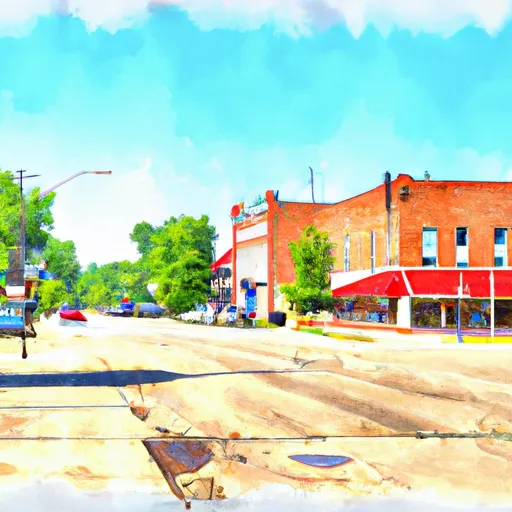-
 Snoflo Premium
Snoflo Premium
Get unlimited access to all our content
With no Ad interruptions! - Start Your Free Trial Login with existing account
Marionville
Eden Index
Climate
8.3
•
Recreation
4.0
•
Community
2.3
•
Safeguard
5.3/10

Marionville, Missouri is a small town located in Lawrence County in the southwestern part of the state. The town experiences a humid subtropical climate, characterized by hot, humid summers and mild, yet sometimes cold winters. Summers are typically warm with average temperatures reaching the mid-80s Fahrenheit, while winters see average temperatures in the mid-30s to low 40s.
The hydrology constituents in Marionville include several small creeks and springs that contribute to the local water supply. These water sources provide a vital resource for the town's residents and also support the surrounding agricultural activities.
For outdoor enthusiasts, Marionville offers various opportunities for recreation. The town is surrounded by picturesque countryside, making it ideal for hiking and biking. Nearby Stockton Lake provides opportunities for fishing, boating, and swimming. The lake is also known for its scenic beauty, with forests and wildlife habitats, making it a popular spot for camping and nature lovers.
In conclusion, Marionville, Missouri experiences a humid subtropical climate, with warm summers and mild winters. Its hydrology constituents include creeks and springs, which contribute to the local water supply. Outdoor recreation opportunities in the area include hiking, biking, fishing, boating, swimming, camping, and enjoying the natural beauty of Stockton Lake and the surrounding countryside.
What is the Eden Index?
The Snoflo Eden Index serves as a comprehensive rating system for regions, evaluating their desirability through a holistic assessment of climate health, outdoor recreation opportunities, and natural disaster risk, acknowledging the profound impact of these factors on livability and well-being.
Climate Health Indicator (CHI): 8.3
Marionville receives approximately
1114mm of rain per year,
with humidity levels near 81%
and air temperatures averaging around
13°C.
Marionville has a plant hardyness factor of
6, meaning
plants and agriculture in this region thrive during a short period during spring and early summer. Most
plants will die off during the colder winter months.
By considering the ideal temperature range, reliable water supplies, clean air, and stable seasonal rain or snowpacks, the Climate Health Indicator (CHI) underscores the significance of a healthy climate as the foundation for quality living.
A healthy climate is paramount for ensuring a high quality of life and livability in a region, fostering both physical well-being and environmental harmony. This can be characterized by ideal temperatures, reliable access to water supplies, clean air, and consistent seasonal rain or snowpacks.
Weather Forecast
Streamflow Conditions
Neosho
Area Rivers
Neosho
Snowpack Depths
Neosho
Reservoir Storage Capacity
Neosho
Groundwater Levels
Recreational Opportunity Index (ROI): 4.0
The Recreational Opportunity Index (ROI) recognizes the value of outdoor recreational options, such as parks, hiking trails, camping sites, and fishing spots, while acknowledging that climate plays a pivotal role in ensuring the comfort and consistency of these experiences.
Access to outdoor recreational opportunities, encompassing activities such as parks, hiking, camping, and fishing, is crucial for overall well-being, and the climate plays a pivotal role in enabling and enhancing these experiences, ensuring that individuals can engage in nature-based activities comfortably and consistently.
Camping Areas
| Campground | Campsites | Reservations | Toilets | Showers | Elevation |
|---|---|---|---|---|---|
| Cowhide Cove - Lake Greeson | None | 542 ft | |||
| Parker Creek - Lake Greeson | None | 684 ft | |||
| Crater of Diamonds State Park | None | 339 ft | |||
| Dam Area - Lake Greeson | None | 431 ft | |||
| Buckhorn - Lake Greeson | 0 | 583 ft | |||
| Pikeville - Lake Greeson | 12 | 568 ft | |||
| Laurel Creek - Lake Greeson | None | 582 ft | |||
| Fair City RV Park | 100 | 317 ft | |||
| Rock Creek - Lake Greeson | None | 560 ft | |||
| Daisy State Park | None | 592 ft |
Nearby Ski Areas
Catastrophe Safeguard Index (CSI):
The Catastrophe Safeguard Index (CSI) recognizes that natural disaster risk, encompassing floods, fires, hurricanes, and tornadoes, can drastically affect safety and the overall appeal of an area.
The level of natural disaster risk in a region significantly affects safety and the overall livability, with climate change amplifying these risks by potentially increasing the frequency and intensity of events like floods, fires, hurricanes, and tornadoes, thereby posing substantial challenges to community resilience and well-being.
Community Resilience Indicator (CRI): 2.3
The Community Resilience Indicator (CRI) recognizes that education, healthcare, and socioeconomics are crucial to the well-being of a region. The CRI acknowledges the profound impact of these elements on residents' overall quality of life. By evaluating educational resources, healthcare accessibility, and economic inclusivity, the index captures the essential aspects that contribute to a thriving community, fostering resident satisfaction, equity, and social cohesion.

